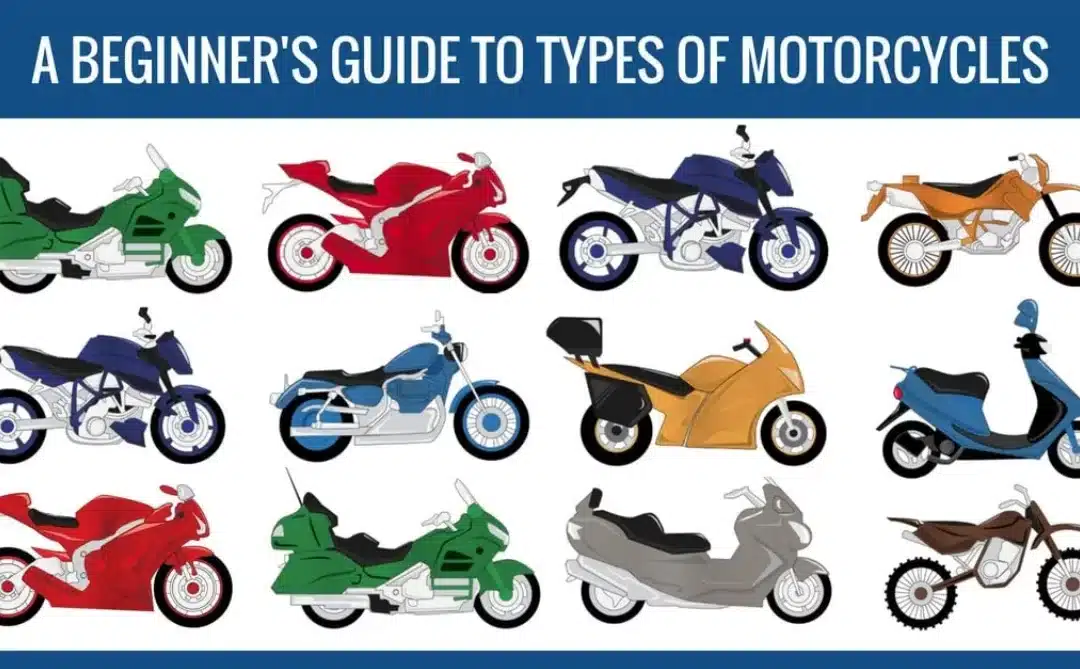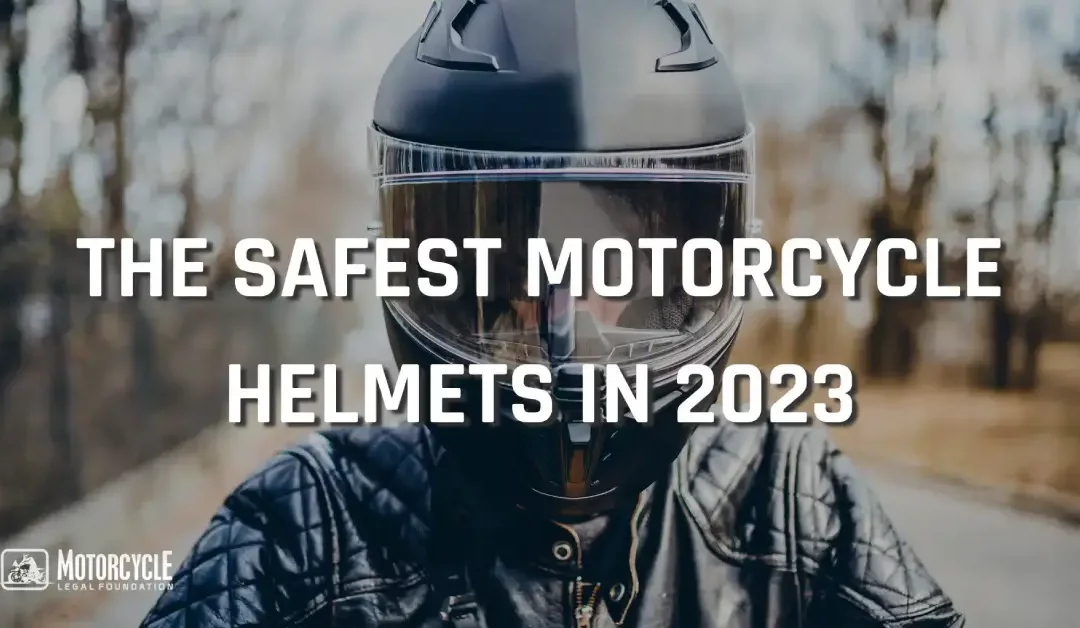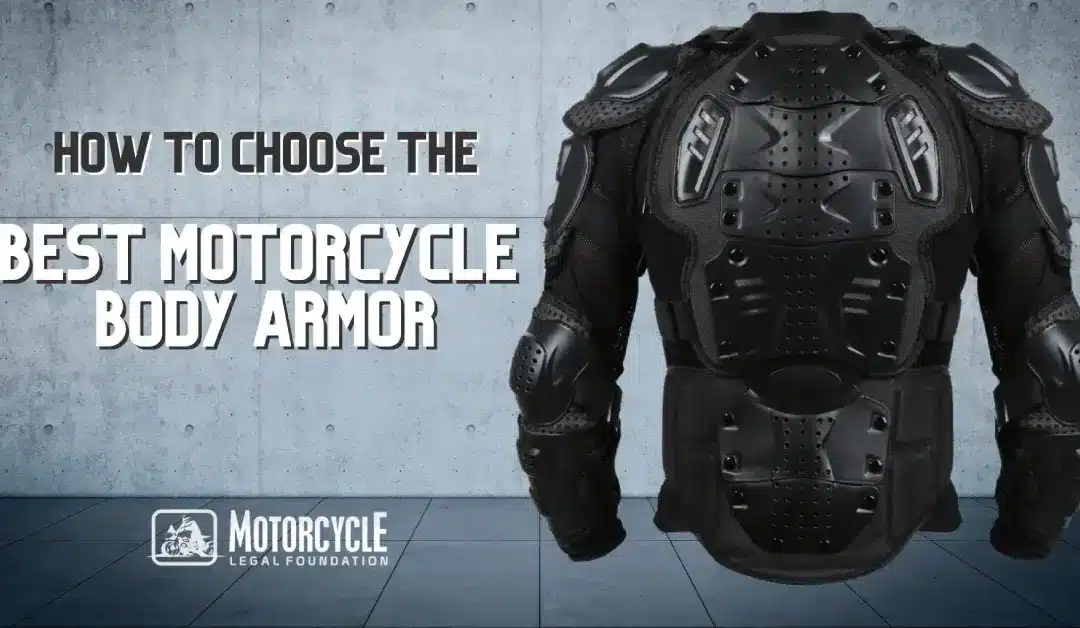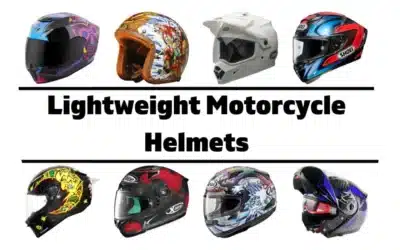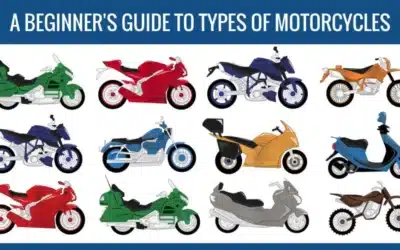Can kids ride on motorcycles? Well, it depends on where you’re riding, and how old the child is.
As a motorcycle rider and enthusiast, it’s only natural for you to share your love of riding with your children. Of course, safety is your primary concern, so getting them the proper headgear and eye protection goes without saying. But, before you let a child ride along with you as a passenger, you need to know what the minimum age for motorcycle passengers is in your state.
It may come as a surprise, as it did for us, that only a handful of states enacted laws to set a minimum legal age for a child to ride as a passenger on a motorcycle. Let’s get into the details.
CAN KIDS RIDE ON MOTORCYCLES?
The short answer is yes, kids can ride as passengers on motorcycles. But, there are specific restrictions for motorcycle passengers in some states.
In Texas, Louisiana, and Washington, a child must be at least 5 years old to ride on a motorcycle. In Hawaii, the age minimum is 7 years old, and in Arkansas, it’s 8. However, the laws differ if the child is riding in a sidecar. As for other states, it’s generally about the height, not the age, of motorcycle passengers. For example, in California and Tennessee, the law states that motorcycle passengers must be able to rest their feet on footpegs when seated in a passenger seat, which equates to a height of about four foot nine on most bikes. Other states have similar provisions.
SAFETY FIRST
Wherever you live or ride, the safety of a child should be your top concern. Motorcycles certainly don’t provide riders with the same level of protection that cars and trucks would in a crash. Motorcyclists are nearly 28% more likely than car passengers to die in a crash per vehicle miles traveled, according to the most recent data.
Most states require that motorcycle passengers have their own seats and footrests. In states that don’t have helmet laws for drivers, passengers under a certain age still may be required to wear a helmet. For example, in South Carolina, all riders or passengers under 21 must wear helmets, while those above 21 don’t have to.
Given the risk of riding, we recommend all riders—kids especially—are fitted with proper motorcycle safety gear. The first priority is a properly fitted helmet, as data shows that helmets are 41% effective in preventing passenger deaths. Along with helmets and eye protection, any child riding a motorcycle should wear appropriate clothing to protect their skin from potential burns while on the bike and better shield them in the event of an accident.
HOW OLD SHOULD A CHILD BE TO RIDE ON THE BACK OF A MOTORCYCLE? STATE-BY-STATE GUIDE
Each state has its own laws pertaining to the operation of motorcycles. Whether you reside in the state and travel locally or happen to be passing through during a road trip, you must be aware of and obey the laws of each state where your travels take you.
Following are the laws governing passengers on motorcycles, including minimum age requirements, for each state:
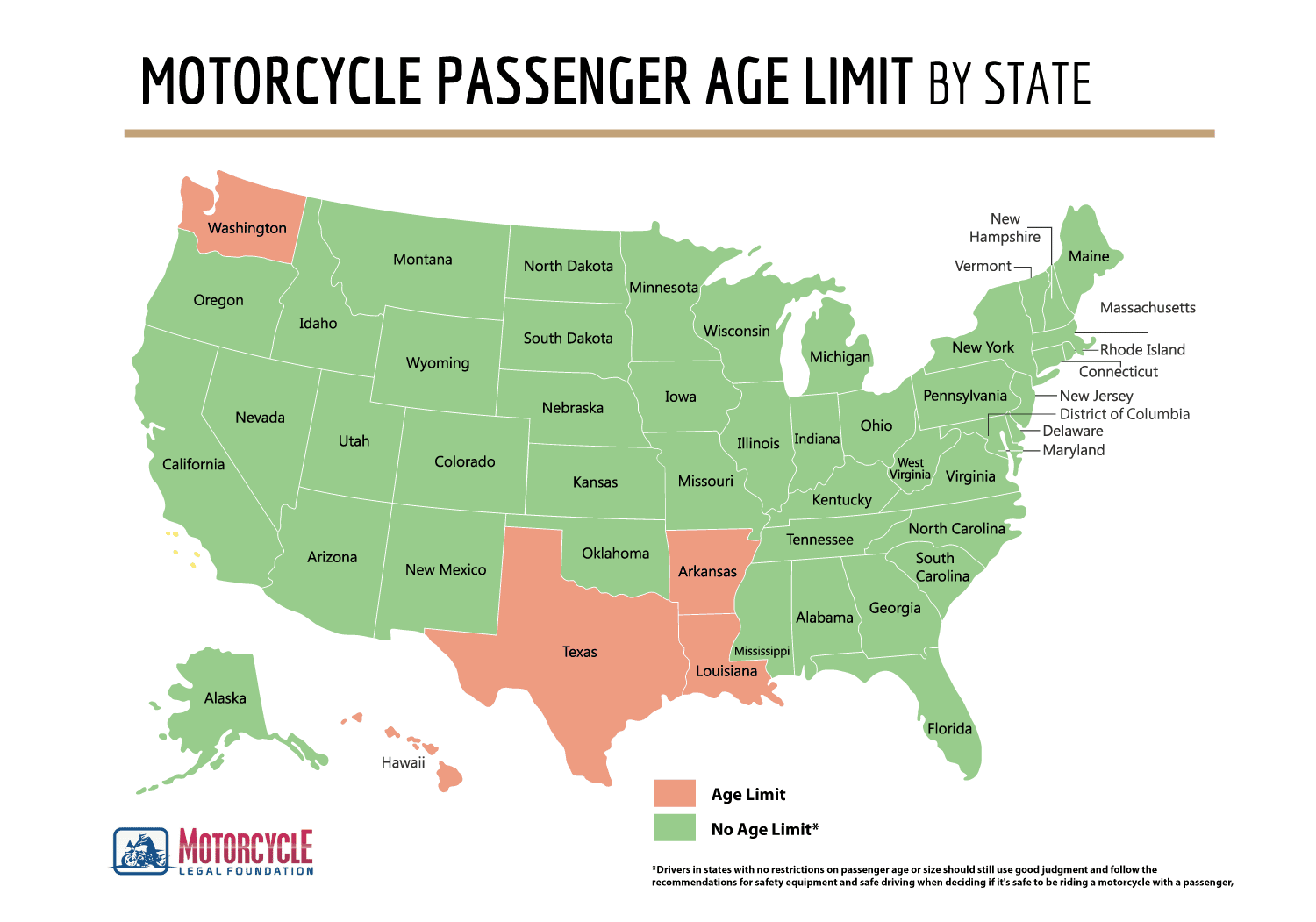
Alabama
To carry a passenger in Alabama, the motorcycle must have footrests, a permanently affixed seat, and a strap or handhold for passengers to hold while riding. No age minimum exists, but all passengers must wear helmets and proper footwear.
Alaska
A motorcycle passenger in Alaska must wear a helmet, be seated in a permanently installed passenger seat, and have footrests available, but there are no minimum age laws.
Arizona
The state of Arizona requires that motorcycles be properly equipped to carry passengers, which includes separate seats and footrests. Passengers under 18 years old must wear a helmet. No minimum age restriction exists for passengers, but riders must have a license and not a learner’s permit to carry a passenger.
Arkansas
Motorcycle passengers must be at least eight years of age in Arkansas.
California
California doesn’t have a minimum age requirement for motorcycle passengers, but has what amounts to a height requirement for passengers by requiring that a passenger’s feet must touch the footrests while seated on the motorcycle.
Colorado
No age restrictions exist for motorcycle passengers, in Colorado, but anyone who is younger than 18 years old must wear a helmet.
Connecticut
Motorcycles must be equipped with a permanently attached seat for the passenger. Connecticut does not set a minimum age for motorcycle passengers, but newly licensed riders cannot carry passengers for at least 90 days, and riders who got their license before 18 years old must wait six months before riding with a passenger.
Delaware
Motorcycles must have a passenger seat and footrests to carry passengers, but Delaware does not have a minimum age for passengers. Both driversiders and passengers must be in possession of a helmet.
Have You Been Involved In A Motorcycle Accident?
Our professional legal team screens submissions and assigns cases to some of the best motorcycle lawyers in the US.
District of Columbia
Washington, D.C. requires a passenger seat and footpegs, but it does not have a minimum age for motorcycle passengers.
Florida
No age minimum exists for motorcycle passengers in Florida, but anyone younger than 21 must wear a helmet when riding either as an operator or passenger.
Georgia
Motorcycles must have a passenger seat and footrests to carry passengers. There is no age minimum in Georgia, but riders and passengers must wear helmets.
Hawaii
In Hawaii, you must be at least 7 years old to ride on a motorcycle, and bikes must have separate seats and footrests for passengers Anyone younger than 18 years of age must wear a helmet.
Idaho
Motorcycles must have a passenger seat and footrests. No minimum age for passengers in Idaho, but helmets must be worn by anyone younger than 18.
Illinois
Motorcycles designed and equipped for two people may be used to carry a passenger without any age restriction in Illinois.
Indiana
In Indiana, motorcycles must have separate seats and footrests for passengers, but there’s no age restriction. Those younger than 18 must wear a helmet.
Iowa
Motorcycles that have separate seats and footrests for them may carry passengers without an age restriction in Iowa. Helmets are required for anyone younger than 18.
Kansas
In Kansas, motorcycles equipped to carry passengers may do so without regard to age.
Kentucky
Passenger seats and footrests are required to carry a passenger in Kentucky, but no minimum age requirement exists. Helmets must be worn by anyone younger than 21 years old.
Louisiana
A passenger must be at least five years old to be a passenger in Louisiana. The motorcycle must have a passenger seat, and the child must wear a helmet.
Maine
Passenger seats and footrests are required to carry a passenger, but there is a minimum age for motorcycle riders in Maine. The state has a helmet law for anyone on a motorcycle who is under 18.
Maryland
While the state cautions adults to be mindful of the risks of children riding as passengers, Maryland does not set a minimum age requirement.
Massachusetts
Massachusetts does not set a minimum age for motorcycle passengers, but everyone on the bike must wear a helmet. The motorcycle must have a secure seat and separate footpegs, and passengers must be able to place their feet firmly on the rear footpegs.
Michigan
Passengers must be able to reach the footrests when seated; otherwise, there is no age restriction for passengers in Michigan. The law includes an exemption for passengers who cannot comply because of permanent physical disability.
Minnesota
A passenger seat and footrests must be installed, and helmets are worn by anyone under 18, but the state of Minnesota does not have a minimum age for passengers.
Mississippi
No minimum age restriction for passengers exists, in Mississippi all riders under the age of 21 must wear a helmet.
Missouri
Missouri does not have an age minimum for motorcycle passengers, but all riders must wear a helmet. The bike must have a proper seat for two and passenger footrests.
Montana
A passenger seat and footrests must be installed and children under 18 must wear helmets; otherwise, Montana does not set a minimum age for passengers.
Nebraska
No age restrictions exist for motorcycle passengers in Nebraska, but passengers must have separate footrests, and all riders must wear a helmet.
Nevada
No age restrictions exist for motorcycle passengers in Nevada as long as they can reach the foot pegs or footrests and have the ability to hold onto the rider or a handhold.
New Hampshire
A passenger seat and footrests are required, but no minimum age requirement exists for motorcycle passengers in New Hampshire. The law does require that riders and passengers younger than 18 wear helmets.
New Jersey
There is no minimum age requirement, but motorcycle passengers in New Jersey must be able to reach the foot pegs when seated. Only a motorcycle designed and equipped to carry more than one person may carry a passenger.
New Mexico
There is no minimum age requirement for passengers, but only a motorcycle designed and equipped to carry more than one person may carry a passenger.
New York
Technically, a child of any age can ride a motorcycle in New York, but the riders must be able to rest their foot on a footpeg. All passengers must wear a helmet.
North Carolina
There is no minimum age requirement for motorcycle passengers in North Carolina, but only a motorcycle designed and equipped to carry more than one person may carry a passenger.
North Dakota
The state does not have restrictions on motorcycle passengers, but all passengers must have access to footrests and those under 18 must wear a helmet.
Ohio
No minimum age for passengers in Ohio, but passengers must have footrests and a strap or solid handholds. All riders under 18 must wear a helmet, as well as passengers of riders who have been licensed for less than a year.
Oklahoma
No minimum age for passengers in Oklahoma, but all motorcycles should have passenger footrests.
Oregon
A passenger seat and footpegs are required, but Oregon does not have a minimum age for motorcycle passengers.
Pennsylvania
Pennsylvania does not have a minimum age for passengers, but separate Passenger seats and footpegs are required.
Rhode Island
In Rhode Island, you must have a secured passenger seat backrest for all passengers younger than 12 years old. Additionally, the child must be tall enough to be able to reach the footrest.
South Carolina
Passenger seats and footpegs are required, but the South Carolina does not have a minimum age requirement for motorcycle passengers. Riders younger than 21 must wear a helmet.
South Dakota
South Dakota does not have a minimum age for motorcycle passengers, but passenger seats and footpegs are required and all riders under 18 must wear a helmet.
Tennessee
In Tennessee, motorcycle passengers must be able to reach the footpegs, but there’s no specific age requirement.
Texas
Children must be at least five years old to ride on a motorcycle in Texas.
Utah
Passenger seats and foot pegs are required, but Utah does not have a minimum age for motorcycle passengers.
Vermont
Vermont doesn’t have a minimum age for motorcycle passengers, but Ppassenger seats, hand holds and foot pegs are required. All riders must wear a helmet in Vermont.
Virginia
No minimum age has been established for motorcycle passengers in Virginia, but passengers must have their own seat and set of footpegs.
Washington
Children must be at least five years old to be passengers on a motorcycle in Washington State.
West Virginia
Passenger seats, foot pegs and helmets are required, but there’s no minimum age for motorcycle passengers in West Virginia.
Wisconsin
Passenger seats, helmets and and foot pegs are required, but Wisconsin does not have a minimum age for passengers.
Wyoming
In Wyoming, motorcycles must have separate seats and footpegs for passengers, but there is no minimum age requirement.
All of these laws are accurate as of the time of publishing. Check with the states where you intend to ride to make certain that carrying a passenger does not violate their laws.
Have You Been Involved In A Motorcycle Accident?
Our professional legal team screens submissions and assigns cases to some of the best motorcycle lawyers in the US.
HOW TO PREPARE FOR RIDING ON A MOTORCYCLE WITH A CHILD
Regardless of what laws say about minimum ages for passengers, riding with a child who cannot comfortably rest both feet on the passenger foot pegs is unsafe. Assuming that your child meets that minimum requirement, here is how to get started:
- Make sure your bike meets the passenger requirements in your state, which likely includes having a passenger seat and rear footpegs.
- Your child needs a helmet that fits properly.
- The child should wear shoes or boots and protective eyewear and clothing.
- Show the child how to buckle and unbuckle the chinstrap. Emphasize the importance of keeping it buckled while on the motorcycle.
- Correctly position the child on the seat with feet on the pegs. Show the child how to hold you or handholds and stress the importance of doing so throughout the ride.
- Caution the child against making sudden moves while the motorcycle is in motion.
- Remind the child not to attempt to get off the motorcycle until you instruct them.
- Do a last-minute safety check of the motorcycle before heading off on your ride.
- Remind the child not to touch moving parts.
- Do not exceed the motorcycle’s weight limitations.
- Avoid high speeds and sharp turns.
Long pants and long sleeves prevent burns from arms and legs coming into contact with hot surfaces, such as exhaust pipes. Everyone, including passengers, should wear them when riding. Protective clothing can also help reduce injuries, particularly during minor accidents or in case you lose balance and drop the motorcycle when stopped at a light.
You can safely share the joy of riding a motorcycle with your child, but be patient with it. First, research the minimum age restrictions that may exist, and then, ensure that you, your motorcycle, and your passenger have the right equipment to make it a safe experience.


